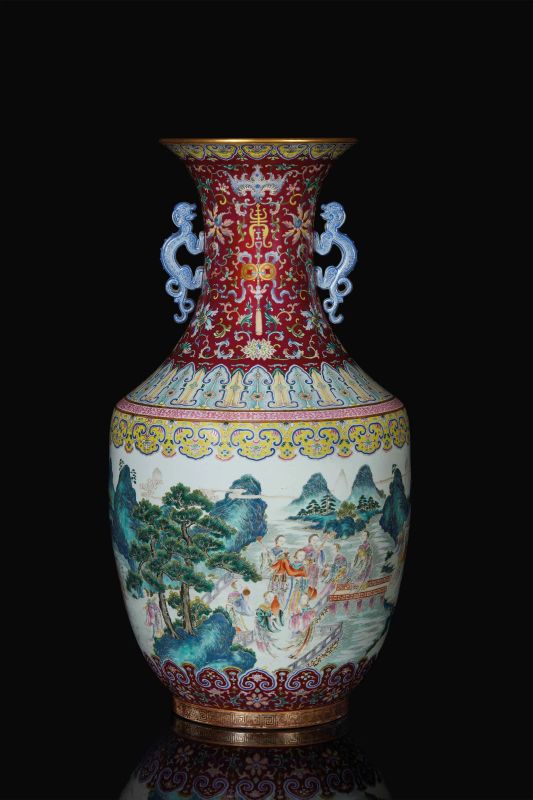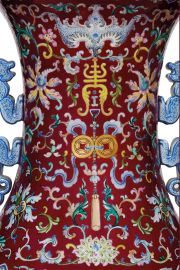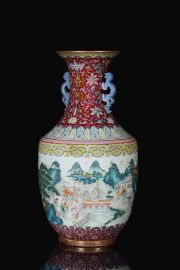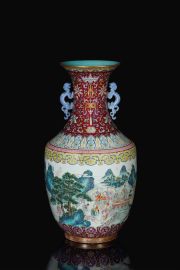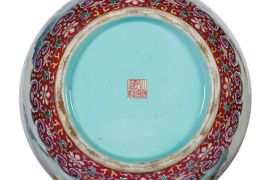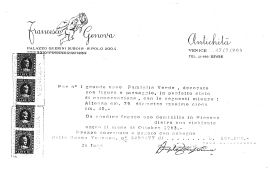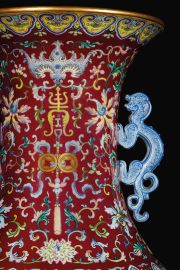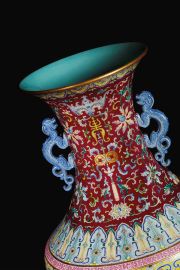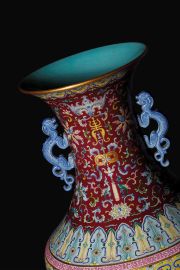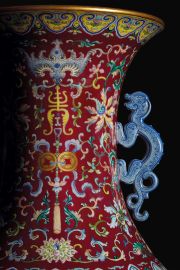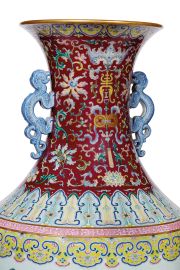A MAGNIFICENT IMPERIAL LARGE FAMILLE ROSE VASE, IRON-RED QIANLONG IMPERIAL 6-CHARACTER SEAL MARK AND OF THE PERIOD (1736-1795)
A MAGNIFICENT IMPERIAL LARGE FAMILLE ROSE VASE, IRON-RED QIANLONG IMPERIAL 6-CHARACTER SEAL MARK AND OF THE PERIOD (1736-1795)
A baluster-shaped vase with an elegantly tapering neck with two applied archaistic dragon handles. The ruby-red ground of the neck is decorated on both sides with large bats and coins over a flowering lotus amidst stylised chrysanthemums in light-coloured glazes. Two bands run around the shoulder, the first composed of tiny flowers and branches in a rose hue; the second, above, composed of stylised petals and flowers. The ovoid body is finely painted with a continuous landscape depicting a procession of female figures playing musical instruments, framed by two bands of ruyi sceptre heads. The lip is gilded; the foot ring is glazed in iron-red and decorated with meander motifs, also gilded. The interior and the bottom of the vase are glazed in monochrome turquoises. Height: 75 cm. Diameter: ca. 40 cm
清乾隆 胭脂红地粉彩仕女奏乐纹双螭耳撇口瓶《大清乾隆年制》款
An export licence is available for this lot
This magnificent vase combines a wealth of traditional symbols of luck and good fortune with the allure of the Imperial porcelains. The large size and the exceptional quality of the painting mark it as a piece of particular importance; it would not be mistaken to imagine that it was commissioned for a special occasion. The style, the form, the size and the sophisticated quality of the painting of the flowers, the ramages and the symbols of good fortune are very similar to those of an important Imperial vase sold by Pandolfini Casa d’Aste on 28 October 2014 (lot 31). In both cases, the quality of the famille-rose decoration is outstanding.
The vase is adorned with several auspicious symbols such as bats, lotus flowers and coins, as well as finely-drawn plant volutes.
Upside-down bats are depicted on both sides of the neck. The bat symbolises happiness and joy, while the Chinese word for ‘turned upside down’ is homophonous with ‘arrive’. The motif therefore symbolises the arrival of happiness – and to reinforce the message, the bats hold the symbol for longevity in their mouths.
On this vase, happiness and longevity are accompanied by golden coins. The best-known form of ancient Chinese money is the copper coin with a square hole at the centre, a form which refers to the idea of a circular universe containing a quadrangular Earth. The form was chosen during the reign of the first emperor of the Qin dynasty (221–206 BCE) to standardize coinage throughout the Empire. The form is an emblem of wellbeing and high social standing and as such strengthens the meaning of abundance and wealth.
The two handles attached to the neck are in the form of kui dragons. The archaic form of the blue dragon handles, as of the vase itself, was common on the porcelains of the reign of the Qianlong Emperor. Another detail that frequently marks works from this period is use of glazes in the pink colour family; here, these shades are used in the lively decoration that encircles the body of the vase, composed of figures in a continuous landscape scene.
Thanks to the size of the vase, the painter had a huge ‘canvas’ on which to work – and he exploited it to the full, painting a complex and interesting scene. In the background, the magical Kunlun mountain to the west, beyond the mythological Moving Sands (Liúshā [流沙]) desert, which was said to lie between the Tian Shan (‘Mountains of Heaven’) in central Asia and the source of the Yellow River. In popular Chinese culture, Kunlun was a mystical place, out of time, where there was no pain nor death, where all the pleasures abounded and the arts flourished: joyous music, dance, poetry and divine festivals.
The legendary mountain is inhabited by fantastical beings and shamanic emissaries, among whom are the Jade Maidens and Xiwangmu, goddess of ancient Chinese religion, dispenser of prosperity, long life and eternal happiness. The Jade Maidens act as the goddess’ messengers; they communicate mystical revelations and present divine foods to those who, blessed by the goddess, are invited to attend her banquets. Tang-dynasty poet Wei Ying-wu describes them as ‘bevies of sublime beings flying to the Queen Mother of the West’. In this representation, the Jade Maidens are entertaining Xiwangmu with music and dance: players of bells, flutes and mouth-organs intertwine with bearers of vases and lanterns, in an ongoing celebration.
During the Tang period, when music had attained a primary role in culture, it was in Kunlun that the Chinese began fabricating different types of bamboo flutes intended to reproduce a ‘fundamental’ tuning. Kunlun was also the location of music schools for girls who became players at court.
The painting around the body of the vase is framed by flowers and ruyi sceptres on a ground that is ruby red below and yellow in the upper portion. The head of the ruyi (literally, ‘as [you] wish') is often associated with the iconography of the lingzhi mushroom which, according to popular belief, grew when a virtuous ruler sat on the throne and the Empire enjoyed peace and prosperity. Their inclusion in the decoration thus represented a compliment to the reigning emperor.
The Famille Rose Chinese Porcelains
The Famille Rose represents for technical perfection and decorative ability the crucial moment of Chinese ceramic production. Pink enamels were introduced to Chinese artistic porcelain manufacture only in about 1720, when new colourings obtained using a mix of auric chloride and tin appeared on some objects made in both the Imperial manufactories of Peking and in the artistic crafts workshops in Canton, debuting in decorative details on enamelled metals and porcelains.
The characteristic pink color is obtained from an enamel acquired from ‘Purple of Cassius’, introduced in China by the European Jesuits. Numerous western missionaries worked in the court of the emperor Kangxi (reign 1662-1722). They were much appreciated by the sovereign for their knowledge in the scientific and artistic field. The Cassio purple was discovered in 1650 by the Dutch physicist Andreas Cassius of Leiden. Nevertheless, the discovery, in Europe, that gold dust could be transformed to produce a red colouring actually predates Cassius’ find: in about 1560, no other than Benvenuto Cellini wrote of the phenomenon in his Treatises on goldsmithing and sculpture. The introduction of pink to the palettes of the Jingdezhen ceramists changed taste and fashions. Not only in China: in Europe, the new tones – softer and more opaque with respect to the brilliant famille verte enamels – were very popular and perfectly adapted to the frivolity – which extended to colour – of the nascent rococo style. The new colouring, known to the Chinese alternately as fencai or ruancai (both of which may be translated as ‘soft colour’) or yangcai (‘foreign colours’, pointing up the non-Chinese origin of this palette), adapted perfectly to use on all the vase sizes manufactured in Jingdezhen for sale on the domestic Chinese market and for shipment to Europe, intermediated by one of the many European trading companies operating along the coasts of southern China. Famille rose enamel decoration remained popular through the 1700s and was in constant use even in the 19th century and into the 20th. Like the term ‘famille verte’, the ‘famille rose’ denomination was coined in 1862 by Albert Jacquemart and Edmond Le Blant in their book entitled Histoire artistique, industrielle et commerciale de la porcelaine. It goes without saying that the ‘definition’ inherent in the name is actually rather generic, embracing as it does an extraordinary variety of porcelains and polychrome decorations on which pink enamel nevertheless always appears. What is certain is that famille rose decoration is highly variable, although the porcelain itself was in all cases of excellent quality.
The Qianlong Era
The 18th century, the ‘golden century’ of the Celestial Empire, was ushered in during the reign of the grandfather of the Qianlong emperor, the Kangxi emperor (1662-1723), continued through the reign of his son the Yongzheng emperor (1723-1735) and closed with the reign of the Qianlong emperor (1735-1795). All three merited the appellative of ‘enlightened despot’, a title also accorded to several Western rulers.
Several significant happenings marked the course of this prosperous era in Chinese history – such as an incredible increase in the population, expansion of the Imperial lands, great strides in intellectual and cultural life and a significant upturn in exchanges with the Western world.
Qianlong was not just the Son of Heaven for his Chinese subjects; he was also the Khan of Khans for the Mongols, the Chakravarti (‘ruler whose wheel is always turning’, absolute ruler) for the Tibetans, and so on: he was the supreme ruler of a multiethnic empire, the unity of which rested within his person.
The Qianlong emperor is strongly characterised as a warrior ruler is strong; the image was in fact promoted by the emperor himself for the express propose of creating a link with the memory of his grandfather, the Kangxi emperor, a great military leader whose achievements included ‘completing’ establishment of Manchu rule. But it was not the only image the emperor sought to project.
Again like his ancestor Kangxi, who at his court brought together illustrious intellectuals and scientists (among whom Jesuits in China on evangelical missions), Qianlong played an important role in Chinese culture. Himself a poet, he encouraged studies and works that drew on the Manchu traditions in language, history and religion: he worried that excessive integration with the majority ethnicity han could in some manner ‘pollute’ the legitimacy of the ruling class.
The emperor’s victories contributed to increasing knowledge of geography and Qianlong was committed to spreading news of new territorial acquisitions throughout the empire. He promoted local gazettes but above all he gave his blessing to production of new maps which comprehended recent conquests – and for this task he exploited the Jesuit scholars at court. Thanks to the missionaries’ contacts with Europe, these maps were available in Europe almost as soon as they were drawn up.
But the most important of the cultural undertakings during the reign of the Qianlong emperor was indubitably the production of the Siku Quanshu, the ‘Complete Library of the Four Treasuries’, an anthology uniting all the works ever written in Chinese up until that time, with no distinction as to genre, era or length. The term ‘Four Treasuries’ refers to the four series or sections of the Siku Quanshu into which the texts are classified: Classics, Histories, ‘Masters’ (art, science and philosophy) and Collections; that is, Chinese literature. Hand-copied between 1773 and 1782 with the collaboration of 361 scholars, this massive collection comprised 36,000 volumes for a total of 4,7 million pages reproducing about 3,500 works in their entirety. Qianlong hoped that by sponsoring this work he would be included in the pantheon of great men of letters, like his grandfather.
The last years of the reign of the Qianlong emperor coincided with the end of China’s ‘golden’ 18th century and the beginning of the decline of the Empire. After Qianlong’s death, in the wake of aggressive English trade policies and China’s defeats in the resulting Opium Wars (among other debacles on the international stage), the millenary Empire wound down to its definitive end.

